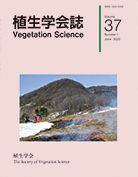Invasion by alien plants that were introduced intentionally or unintentionally is a major issue facing ecosystem conservation around the world. In Kochi and Aki Cities in Kochi Prefecture, Japan, Bischofia polycarpa (Phyllanthaceae) has been planted along streets and in parks, although this species was misidentified as B. javanica for many years. If the ecological traits of B. polycarpa are similar to those of B. javanica, which is known to be an invasive alien tree, it is likely that escaped regenerated trees will expand into the surrounding vegetation. In this study, we assessed the expansion potential of B. polycarpa based on field and experimental surveys of planted and escaped tree distributions, seed productive traits, seed germination traits, and growth traits of current-year seedlings. In Ushioe, Kochi City, 38 planted or escaped B. polycarpa trees were found at nine sites in parks, school gardens, and roadsides. Most of these seedlings and saplings were found around planted trees;however, some were found under trees used by birds as perches far from any bearing trees of B. polycarpa. This species produces many fruits (3-19 fruits per infructescence) and seeds (0-6 seeds per fruit) with a high viable seed rate (>88%). In this study, B. polycarpa seeds showed light requirement for germination, but seed dormancy was broken under a short period of moist chilling treatment;thus, the rate of seed germination was high (>85%). Current-year seedlings showed a high shoot growth rate and high above- and belowground biomass under shaded conditions. These results suggest that most seeds will be dispersed near planted trees, but some will be dispersed farther away, depending on the spatial distributions of trees used by birds as perches. Most of these dispersed seeds will germinate the following spring. The seedlings of this species have high shade tolerance, and some might be able to survive on forest floors. If saplings also have a high shade tolerance and are able to survive under unstable conditions, this species is expected to expand into secondary forests and river floodplains in urban areas. To prevent unintentional expansion of B. polycarpa, it is essential to monitor the invasion status around planted trees and to prune trees before fruit maturation.
View full abstract
